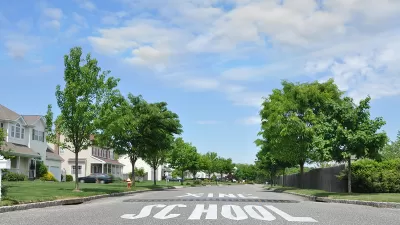Not only are suburbs growing, many of the larger, older cities that had reversed decades of population decline, are now losing population, again. The biggest losers: counties with the greatest population densities.
The U.S. Census Bureau released population estimates on March 23. The "data confirmed that suburban areas lead growth." To understand the relationship between county population density and population change based on residents leaving and arriving in counties, Mike Maciag, Governing's data editor, "compared the Census Bureau's updated domestic migration estimates for all counties within metro areas, which were then grouped by population density."
The 146 most densely populated counties lost a total of 539,000 residents to other parts of the country over the 12-month period ending in July, representing the largest decline in recent years.
Maciag details the population loss in St. Louis and Baltimore which have seen their more affluent suburbs grow.
Over the 12-month period ending in July, the city of St. Louis lost 1.1 percent of its population -- the largest decline of any large Census-designated county nationally. The steady stream of residents leaving has led to thousands of vacant homes and lots, particularly on the north side. The city's Land Reutilization Authority currently holds approximately 12,000 vacant properties, far more than comparable cities.
Central cities' losses are their suburbs' gains. Case in point, Baltimore.
A somewhat similar scenario is playing out in the city of Baltimore, where the population declined at the same rate. A net total of 11,000 residents moved out of the city -- many to surrounding suburban neighborhoods -- nearly doubling the domestic migration loss of the prior 12-month period.
“The suburbs in Baltimore are no more just middle-class professionals, they’re much more diverse,” says Andrew Cherlin, a Johns Hopkins University professor.
See the Census Bureau's press release for tables showing showing population growth and loss from July 1, 2015 to July 1, 2016
- Top 10 Largest-Gaining Counties (Numeric Change), led by Maricopa County, Arizona.
- Top 10 Fastest-Growing Counties (Percent Change, Counties With a Population of 10,000 or More), led by San Juan County, Utah.
- Top 10 Largest-Declining Counties or County Equivalents (Numeric Change), led by Cook County, Illinois.
- Top 25 Fastest-Growing Metro Areas (Percent Change), led by The Villages, Florida.
FULL STORY: Population Declines Accelerate in Many Large Urban Areas

Planetizen Federal Action Tracker
A weekly monitor of how Trump’s orders and actions are impacting planners and planning in America.

Maui's Vacation Rental Debate Turns Ugly
Verbal attacks, misinformation campaigns and fistfights plague a high-stakes debate to convert thousands of vacation rentals into long-term housing.

San Francisco Suspends Traffic Calming Amidst Record Deaths
Citing “a challenging fiscal landscape,” the city will cease the program on the heels of 42 traffic deaths, including 24 pedestrians.

Defunct Pittsburgh Power Plant to Become Residential Tower
A decommissioned steam heat plant will be redeveloped into almost 100 affordable housing units.

Trump Prompts Restructuring of Transportation Research Board in “Unprecedented Overreach”
The TRB has eliminated more than half of its committees including those focused on climate, equity, and cities.

Amtrak Rolls Out New Orleans to Alabama “Mardi Gras” Train
The new service will operate morning and evening departures between Mobile and New Orleans.
Urban Design for Planners 1: Software Tools
This six-course series explores essential urban design concepts using open source software and equips planners with the tools they need to participate fully in the urban design process.
Planning for Universal Design
Learn the tools for implementing Universal Design in planning regulations.
Heyer Gruel & Associates PA
JM Goldson LLC
Custer County Colorado
City of Camden Redevelopment Agency
City of Astoria
Transportation Research & Education Center (TREC) at Portland State University
Jefferson Parish Government
Camden Redevelopment Agency
City of Claremont




























